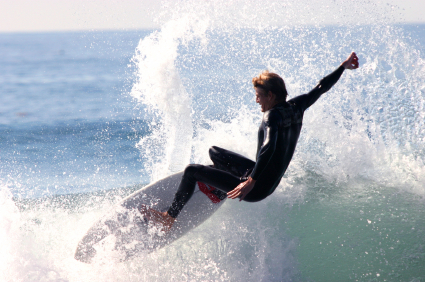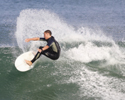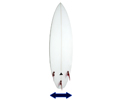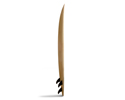Length
Finding The Sweet Spot Reduces Your Foam
Where is the best place to stand on a surfboard? If there is a sweet spot how does it help the surfer get the most out of a wave?
 Each surfboard has a tipping point. This is defined as the point on the board where there is an equal amount of weight and volume on either side of the board, both forward and in back. To find this spot on the board all you need to do is hold the board out on your hand like a scale. Picture someone holding their board palm up, against the board's bottom surface, until the board is completely level. The hand is at the sweet spot.
Each surfboard has a tipping point. This is defined as the point on the board where there is an equal amount of weight and volume on either side of the board, both forward and in back. To find this spot on the board all you need to do is hold the board out on your hand like a scale. Picture someone holding their board palm up, against the board's bottom surface, until the board is completely level. The hand is at the sweet spot.
The reason this spot is important is that it tells us where to position our feet on the board. The tipping point/sweet spot should be between your feet while riding. This point will be closer to the rear of the board in small wave boards, while it creeps toward the front in bigger wave boards. This helps to explain why you see a lot of good surfers using smaller equipment. Yes, they are supremely talented surfers who have the balance to use smaller boards, but they are also riding boards appropriately sized for their body type.
Most pro surfers are 6 feet tall or shorter. It makes sense they will need smaller boards if they are to position their feet correctly and squeeze every last drop of performance from the board. It almost seems counter-intuitive. While a mediocre surfer may want to surf a bigger board to aid in paddling and stability, once he stands up on the board it may prove difficult to perform the maneuvers he desires. Should we go shorter?
Shaper extraordinaire Rusty Preisendorfer believes that while the public's performance shortboards typically follow the design characteristics professional surfers use in above average conditions, we need to "go shorter, wider, thicker, flatter, and the fun will find its way back into your everyday surfing experience." Rusty recommends going at least 4 inches shorter than your standard performance shortboard, with the possibility of going shorter if ability allows.
The idea of surfing smaller boards without losing paddle power is exactly where many shapers believe the sport will take us next. The only way to do this is to start taking a closer look at a board's density, surface area and volume. It's been proven that extra width and thickness can make up for the lack of length in a board. We have all seen the footage of Kelly Slater charging (and winning) the most recent Pipeline Masters on his 5'11" Deep Six. As we learn more about shaping to a specific volume, and where to place this volume, we can all go smaller.















2 Comments